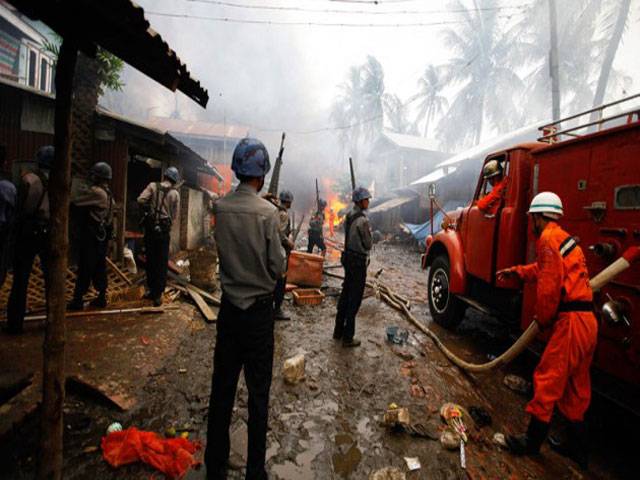Azad Essa
A few weeks ago, a picture showing hundreds of dark-skinned men splayed across a beach was passed around on Facebook. The men appeared to be either asleep, or more likely, dead. They lay against each other, their faces averted from the camera, while men in fatigues holding semi-automatic weapons towered over them. The caption read: “Continuity of massacre of Muslims of Burma by Buddhists. More than 1,000 killed yesterday. Please share.”
After some probing, the photograph turned out to be a fake. But all fabrications aside, there actually is a bona fide crisis unfolding along the Burma and Bangladesh border – despite the poppycock on social media, the sham did raise questions that traditional media have largely ignored.
Violence between Buddhists and Rohingya Muslims in Burma’s Rakhine region erupted in June after the alleged rape and murder of a Buddhist girl by Muslim men. The scale of violence has led to scores of deaths and the mass displacement of tens of thousands of people. After a state of emergency was declared in the province, the entry of Burma’s security forces lent another dimension to this conflict. Amnesty International said in early August that Rakhine Buddhists, together with security forces, purposefully meted out devastating violence against the Muslim minority.
This violence is only the latest chapter in a long history of state-sponsored repression against the Rohingya. It began when Burma began its project of “Burmanisation” in the 1950s, with its lofty aims for racial purity and the nationalisation of resources following the end of British rule. The minority was targeted in pogroms in 1978, stripped of their citizenship in 1982 and became the perfect foil for rampant human rights abuse, including slave labour and torture, that led to a second exodus into Bangladesh in 1991-1992.
But not only are the Rohingya a disenfranchised people, they are dark-skinned Muslims with little relevance, representation and significance to anyone. Unable to deal with a matter the much-vaunted Nobel peace laureate Aung San Suu Kyi has not endorsed, the western world has tiptoed around the issue. Aung San Suu Kyi’s silence is evidently an attempt to placate her constituency ahead of general elections in 2015, and to criticise her now would be like admonishing Nelson Mandela in the run-up to the 1994 election in South Africa. But unlike South Africa in the 1990s, Burma is not on the verge of some tremendous political shakeup; while the Rohingya are being sacrificed as collateral damage in the greater project of the democratisation of Burma, Aung San Suu Kyi is missing an extraordinary opportunity to live up to her reputation.
Meanwhile, in that parallel universe known as the “Muslim world”, the Rohingyas have joined Palestine, Kashmir, Iraq and Afghanistan on the list of flagship Muslim causes. In a region that is home to the world’s greatest concentration of Muslims, the delayed reaction of neighbouring Indonesia, Malaysia and Brunei is startling. Last week, Bangladesh, another Muslim country, ordered three NGOs to stop providing food and other humanitarian assistance to Rohingyas in the border area, claiming it did not want to encourage more asylum seekers to its shores. Already 40,000 unregistered Rohingyas live in makeshift camps in Bangladesh, and according to the UN Refugee Agency, the latest violence will result in a greater influx of people – whether Bangladesh likes it or not.
While Burma’s Muslim neighbours struggle to respond, Saudi Arabia has thrown money at the problem. It has fallen to Turkey to act decisively by further extending its newly found benevolence to the Islamic world. As images of the Turkish prime minister’s wife sobbing as she witnessed the effects of the violence herself begin to be passed around online – further cementing the Rohingya cause to the long list of Muslims’ suffering – Muslim prayers have bemoaned the global silence as proof of the grand conspiracy against Islam. And yet little is being done by Muslims to actually reverse the treatment of their purported brethren themselves.
It all makes for a rather disempowering picture, but it doesn’t have to. Given how fast a fake picture can spread its way across the world, imagine what we could do with a little engagement. –Guardian
Wednesday, April 17, 2024
In Burma, violence against Muslim minority stumbles into spotlight

3 killed in Malaysia accident laid to rest in Rustam
April 17, 2024
E-transfer policy in KP colleges soon: Minister
April 17, 2024
PPAF gives relief items among affected families in Gwadar
April 17, 2024
Minister directs to ensure fertilizers supply
April 17, 2024
Rail Revival
April 17, 2024
Addressing Climate Change
April 17, 2024
Saudi Investment
April 17, 2024
Political Reconciliation
April 16, 2024
Pricing Pressures
April 16, 2024
Workforce inequality
April 17, 2024
New partnerships
April 17, 2024
Shikarpur crisis
April 17, 2024
Peace quest
April 17, 2024
Democratic harmony
April 16, 2024
ePaper - Nawaiwaqt
Advertisement
Nawaiwaqt Group | Copyright © 2024





